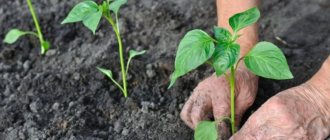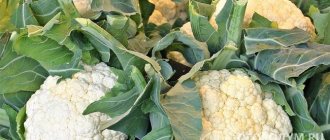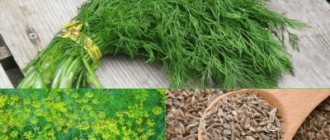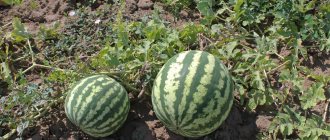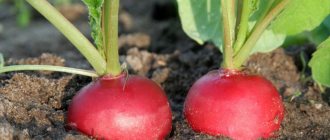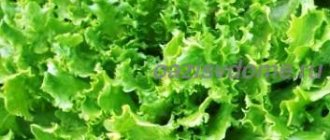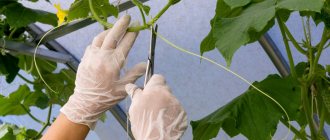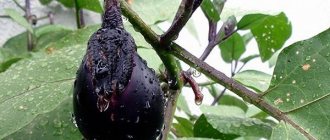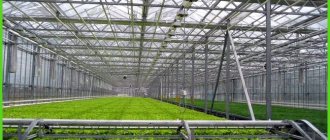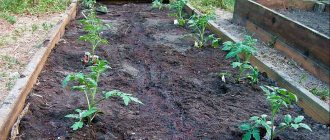Author's rating
Author of the article
Yakov Pavlovich
Professor, Head of the Department of Vegetable Growing
Articles written
153
Cauliflower takes the leading position among healthy vegetables. It is valued for its high nutritional value and hypoallergenicity; it is often found in the diet of children. This dietary product retains its beneficial properties even when frozen. To reap a rich harvest of cauliflower, you need to adhere to the rules for growing and caring for it in the open ground.
General description and stages of development
Cauliflower is an annual plant; it can be sown both in the spring (spring version) and in early autumn (winter version). In one year, not only the head is formed, but also the fruits and seeds. The root system of cauliflower is not well developed, fibrous type, and is located near the soil surface. Harvesting cabbage is already possible 90–170 days after the sprouts appear; the seed material ripens in 200–240 days.
The stem has a cylindrical shape, its height on average is 0.15–0.7 cm, it all depends on the characteristics of the variety. Leaf blades can grow horizontally, straight, or positioned obliquely upward. They are often spiral-shaped. The color of the leaves varies, from light green to blue-green, and a waxy coating is also present. Their length varies between 15–90 cm. Narrow plates are oval, ovoid or elliptical.
There are varieties of cauliflower that consist of individual flowering shoots. In other varieties, the head is formed by twisting the apical shoots, which are highly branched and contain the rudiments of inflorescences. At the stage of formation of 9–12 leaves, the process of tying the head begins. Its shape can be round or flat-round. There are types of cauliflower not only with a white head, but also green, yellow, and purple. There are also specimens with different shades.
At the stage of full ripening, cauliflower begins to develop buds, flowers and fruits with seeds. They are formed in several shoots, in their peripheral part. Small flowers are painted white or yellow. The seeds retain their viability for three years.
Important! The storage period for cauliflower is 7–10 days, but only at a temperature of 0 °C.
Depending on the variety, there are specimens that bloom in the second year, and there are varieties that bloom in the first year of life. According to the ripening period, cauliflower is divided into 3 groups: early (90–110 days), middle (110–135 days) and late (160–170 days). Based on this characteristic, the appropriate time for harvesting cabbage is determined: the first days of June, the last days of July and the end of August.
Biological features
Knowing the biological characteristics of a crop, you will not make mistakes in its cultivation in the future.
- This is a plant with an annual growing season. The head - the head - is nothing more than a crowded flowering shoot. If you are late in harvesting, even by a few days, the inflorescences in the head will separate, begin to bloom, and later produce seeds.
- Cauliflower is a heat-loving plant. Cultivation requires compliance with a temperature range of no lower than 10º and no higher than 25ºС. At low temperatures, the cabbage may not set, or the cabbage will grow small and coarse-fibered. In hot weather, the head of cabbage will set, but will be loose.
- Cauliflower has a weak, fibrous root system, so the surface layer of the soil must be fertile and well-moistened, otherwise you will not get tasty cabbage.
- Sufficient daylight and darkness are necessary for growth. In the light, the head sets faster, but at the same time, with a shortened daylight hours, the heads of cabbage grow dense and large. Therefore, choose a well-lit bed.
Cauliflower is usually white in color. But now there are varieties of orange, purple, and green. But this does not affect the beneficial properties of the vegetable. Thus, orange cabbage varieties contain 25 times more vitamin A than their white counterparts, purple cabbage varieties contain more anthocyanins, and green cabbage varieties contain more antioxidants.
The best varieties of cauliflower
To obtain a rich harvest, it is necessary not only to adhere to certain rules of agricultural technology, but also to know which varieties of cauliflower are best to choose for growing on unprotected soil, and which ones for greenhouse conditions.
For open ground
The following varieties of cauliflower show good results when cultivated in open areas:
- Movir 74. The plant has an early ripening period and is distinguished by high consumer qualities. It is resistant to elevated air temperatures and cold snaps. The diameter of the fruit is almost 23 cm, its weight is 1.4 kg. The variety responds gratefully to frequent but moderate watering.
- Alpha. This hybrid form of early ripening produces a harvest within 60 days. The head has a white color, a smooth surface and a dense structure.
- Consista. Agriculture tolerates slight drops in temperature quite painlessly. Heads of cabbage are harvested after 75–90 days. Their weight is about 800 g.
- Autumn giant. The plant belongs to the late-ripening category, the duration of the growing season is 220 days. A ripened head of cauliflower weighs almost 2.5 kg.
- Yako. This type of cauliflower is suitable for both summer and winter cultivation. It has high productivity rates. The crop is harvested after 65 days. Head weight 820–850 g.
For the greenhouse
To successfully cultivate cauliflower in polycarbonate greenhouses, you should give preference to the following varieties:
- Guarantee. The crop matures within 100 days from the moment it is planted in the ground. The diameter of the head is up to 39 cm. It is painted either white or cream. The variety is not prone to cracking. Head weight 900 g.
- Goat-Dereza. The plant has compact leaves directed upward. Weight of a dense head is up to 800 g. Yield indicators per 1 sq. m. are almost 3 kg. Cauliflower has a universal purpose; it is grown both in summer and spring.
- Metelitsa F The hybrid plant is distinguished by its resistance to adverse environmental factors. The rounded head has a white color and a dense structure. The weight of a ripe head of cabbage is up to 900 g.
- Domestic. The weight of the dense and white head is about 700 g. The variety is valued for its excellent taste and product characteristics.
- Early Gribovskaya 1355. The early ripening variety gained its popularity due to its high consumer qualities and relative ease of care. From the moment the sprouts appear until the head fully ripens, 80–101 days pass. Cabbage weight is up to 900 g. The variety resists cracking.
See also Beijing cabbage: cultivation and care in open ground and in a greenhouse
Harvesting and storage, use in cooking
Collect cauliflower heads as they ripen, when they grow to the size characteristic of the variety. If you do not plan to immediately use the cabbage for food, then cut off the heads of cabbage along with 3-4 adjacent leaves and place them in boxes, baskets or boxes with the cuts facing up. This way the heads of cabbage will appear as if in natural packaging, will not be damaged during transportation, and dirt will not get on them.
For transportation, cut cauliflower with several leaves; they will protect the heads of cabbage from dirt and damage.
Fresh cauliflower does not last long; it quickly loses its beneficial qualities, becomes lethargic, and even turns yellow in the light. In the refrigerator, inflorescences wrapped in cling film can last for a week. But before that, they need to be cleaned of leaves and dirt, disassembled into inflorescences, washed and dried. For the winter, cauliflower is frozen and canned.
Sowing cabbage for seedlings
In order for a vegetable crop to actively grow and develop, you need to know when to sow seeds in the soil and how to care for them.
Seed preparation
Preparatory activities begin in late February. They provide for the processing of seed material to improve the quality of its germination.
For these purposes, a method such as temperature stress is used, where the seed is kept for 15–20 minutes in a container with hot water (+50 °C). After the time has passed, you need to remove the floating seeds, and place the remaining ones at the bottom in a container with cold water for 2-3 minutes. After which they are transferred to a container with a solution of a growth stimulator, potassium permanganate, for 8–12 hours. At the end of the preparatory procedures, the seeds should be washed under running water and dried.
Expert opinion
Stanislav Pavlovich
Gardener with 17 years of experience and our expert
Ask a Question
Advice! You can increase the germination rate of seed by stratifying it by keeping it on the bottom shelf of the refrigerator for 24 hours.
Selection of soil and container
Considering that the roots of agricultural plants are delicate, it is better to plant seeds in the ground in separate pots. Peat tablets will also work. As a suitable substrate, use either ready-made soil for seedlings or a homemade soil mixture consisting of:
- peat (2 parts);
- river sand (1 part);
- humus (1 part);
- rotted mullein (1 part).
The soil for cauliflower should be both nutritious and loose. If the soil is highly acidic, then it is effective to use dolomite flour, lime, and wood ash for neutralization.
Timing and technology of sowing
Depending on the variety, sowing work is carried out at different times. When choosing the timing of planting seeds into the soil, you need to take into account the climatic features of a particular region. The age of seedlings at the time of planting in a permanent place should be 25–30 days. This is especially important for the Moscow region, where conditions for this vegetable crop are not entirely suitable. Such regions are characterized by an abundance of cloudy days; early or mid-ripening varieties are worth growing.
Sowing seeds for seedlings for early varieties should be done at the end of February. For mid-season specimens, it is recommended to plan work for mid-March. Late varieties are best sown in late March.
The seed sowing technology involves performing the following actions:
- Disinfected fertile soil is poured into prepared containers.
- Make indentations no more than 1 cm.
- Place a cauliflower seed in the center and sprinkle with a thin layer of sand. This will protect the sprouts from blackleg, a dangerous disease.
- Moisten with a spray bottle.
- Create a greenhouse effect using a plastic bag and place it in a warm place with diffused light.
Conditions for growing and caring for seedlings
In order to provide seedlings with comfortable conditions for growth, the air temperature in the room must be maintained within +18...+20 °C. When shoots appear, it is reduced to avoid stretching to +6...+10 °C. After 5 days, the temperature is raised to +15 °C. The air humidity level should be in the range of 70–80%; irrigation activities are often carried out with warm water, but in moderation.
Important! At a room temperature of 21 °C or more, ovaries will not form on cabbage inflorescences.
Proper care of seedlings involves loosening the soil, irrigation, and adding nutrients. In the phase of 2–3 true leaves, the feeding procedure is done using wood ash at the rate of 1 glass of product per 10 liters of water. A mullein solution is also suitable, where organic fertilizer and water are taken in a ratio of 1:10.
Picking
Young plants are planted in separate pots, if they were in a common container, or in a heated greenhouse, at the age of 21 days. Before planting in open areas, the plants should remain in a spacious container for another month.
Requirements for growing conditions
Basic recommendations for sowing cauliflower:
- Choosing a location. Preference should be given to a site in full sun. In summer, the heads will need light shade. But only with the help of cabbage leaves. It is important. After all, even a small shadow from neighboring plantings or buildings can cause the seedlings to stretch out and the heads of cabbage to become smaller. At the same time, cabbage beds must be protected from wind and draft.
- The soil. Cabbage grows well in loose, fertile soil. The soil pH should be within the neutral or slightly acidic range. If the soil is too acidic, it can be neutralized by liming the soil, which is carried out during autumn digging. In autumn, organic fertilizers (manure or compost) are also added to the soil. In the spring, future beds can be fertilized with mineral preparations (for example, superphosphate).
- Planting methods. Cauliflower is best grown using the seedling method. Sowing seeds for seedlings can be done from mid-March. Planting in open ground - from mid-May. Specific timing depends on the variety.
- Temperature conditions. Comfortable growing temperature for cauliflower is 15-18°C. If the thermometer drops below these values, the harvest will be small and will lose its true taste. At high temperatures, cabbage growth will slow down and the inflorescences will become loose.
- Harvesting. It is important to comply with the harvest dates (see the relevant section). If this is not done, the heads will become overripe, disintegrate into inflorescences and lose their taste. Such a product is not suitable for storage, and you cannot prepare tasty dishes from it.
When and how to transplant seedlings into open ground
Cauliflower quickly adapts to new conditions if you choose the right place and maintain the distance between seedlings.
Choosing a location: taking into account the rules of crop rotation
In order for the seedlings to have enough lighting and nutrition, it is necessary to plant them in a sunny meadow, protected from drafts. The fertile composition of the soil should be at a depth of up to 40 cm. It is best to plant vegetables in a bed where cucumbers, legumes, onions, garlic, potatoes, and green manure previously grew.
Preparation of beds and placement scheme
When forming a bed for this agricultural crop, it is worth considering that the distance between early-ripening plants should be 30×60 cm. And for late-ripening species, these parameters need to be increased by 10 cm. Preparation of the bed involves adding 1 square meter. m of soil 1 bucket of humus and 1 tbsp. l. nitrophoska.
Direct drop off
The step-by-step process of planting seedlings in open areas is as follows:
- In the prepared area, you need to make holes in accordance with the size of the plant root system.
- Add a handful of humus to each hole.
- Add wood ash (1 tbsp per hole) and mix with soil.
- Moisten the soil and plant the seedling.
- Mulch with humus and compost.
- If possible, it is necessary to darken young plants for 1–2 days.
How to choose the right variety?
You can buy cauliflower seeds everywhere. Breeders are constantly developing new varieties suitable for cultivation in certain regions. When choosing planting material, you need to pay attention to some nuances.
So, the variety must fully comply with the climatic conditions in your region. The types of foreign selection are selected with special care. It is worth carefully monitoring temperature indicators for successful growth of bushes. The type of soil is no less important. A properly selected composition, as well as the acidity of the soil, will be the key to a high yield.
High-quality seeds should be immune to the most common diseases, as well as pests. Professional seed treatment makes the life of a gardener much easier. The need to spray the sprouts with chemicals will be greatly reduced. The most natural cabbage will end up on the table.
When choosing a variety, the size of the fork is also taken into account. Heads that are too large cannot be cooked completely in one go. When storing this vegetable in cut form, you can lose a significant part of the vitamins.
Another important parameter is the length of daylight hours. In the northern regions it should be quite long, and in the southern regions it should be short. It is worth remembering that hybrids do not produce viable, quality seeds. You can try to plant them, but the result will be unpredictable.
If at this stage it is difficult to decide on a variety, it is better to plant several species at the same time. During the observation process, you can select the most comfortable to care for, productive and resistant to diseases.
It is convenient to plant cabbage with different ripening periods at the same time. The harvest can be harvested throughout the season, which, accordingly, will be stored longer.
The best varieties:
- Amethyst. The forks have a violet tint. Their weight ranges from 700 g to 1.1 kg. It has excellent taste, cooks quickly and is suitable for pickling.
- Express. The forks are small, but very tasty, have a pleasant yellowish tint. When growing, you need to spend time preventing pests, and also protect the plantings from the cold at night.
- Malimba. Early ripening hybrid. The head is strong, white, round and slightly flattened. This variety is rich in vitamins and minerals.
- Lilac ball. A very beautiful inflorescence of a rich purple hue. The head is covered with small tubercles, the flesh is quite tender. This cabbage is very beneficial for blood vessels, and it is also a powerful source of vegetable protein. It is used in dietary and therapeutic nutrition.
- Amerigo. It has large leaves that reliably protect the forks from the scorching sun. The variety is resistant to cold, as well as to many diseases and pests. The heads are quite large (weighing about 2.2 kg) and have a pleasant delicate taste.
Features of seedless cultivation of cauliflower
Not only the seedling method is used for cultivating agricultural plants, there is also a non-seedling method for cultivating them. To get the desired result, the main thing is to know its features.
In the open ground
To grow a popular vegetable in the garden, you need to plant the seeds in the soil as follows:
- Make grooves 1 cm deep in the area designated for planting, maintaining a distance of 40 cm between them.
- Moisten the soil with warm water.
- Spread the seed treated with potassium permanganate solution, maintaining an interval of 5 cm.
- Sprinkle with soil and gently compact it.
- Build a frame of arcs and stretch the film over the crops. This technique will protect the cabbage from return frosts.
See also How and how to properly treat cabbage against flea fleas
Alternatively, you can plant seeds in the holes. There should be no more than two or three seeds in each hole. When the seedlings have 3-4 true leaves, you need to remove the weak ones and leave the strongest one.
In the greenhouse
Cauliflower is also grown in protected soil conditions. The beds are also fertilized with organic matter and mineral components, neutralizing acidity if necessary and observing crop rotation. Sowing work is carried out after the snow has melted; the temperature in the greenhouse should be from +15...+18 °C. The depth of planting seeds in the soil is 5 mm; if you deepen them too much, the emergence of seedlings will occur much later.
The soil should be mulched with dry sand, watering should be carried out exclusively with warm water. The picking is done after 10 days. Scheme for planting cabbage seedlings in holes 70x30 cm. It is recommended to place a handful of wood ash, humus and a nutritious complex composition such as “Kemira” in each hole.
Growing seedlings
Seedling material can be purchased ready-made, but it is very important that it is of high quality. To do this, you need to look at what cauliflower seedlings look like in the photo in order to know what points you should pay attention to.
It is also easy to grow seedlings yourself. To do this you need:
- plant 1 seed in disposable cups;
- after emergence, transfer to a cool, bright room;
- shade from direct sunlight;
- water as the soil dries;
- After the first pair of true leaves appear, transplant the seedlings to a permanent place under cover.
The seedlings are planted in holes arranged according to a 30x60 cm pattern. The covering material is left until the threat of frost has passed.
Further care
Caring for a vegetable crop is not difficult if you know agricultural technology and do not make gross mistakes. Plants need irrigation, loosening the soil, and fertilizers.
Watering
You need to water the cabbage without excessive zeal, per 1 square meter. m of soil from 1 bucket of water. Over-wetting the soil is unacceptable. Before rooting, the planted seedlings are irrigated every day, then it is enough to carry out the procedure 1-2 times a week. At the stage of ovary formation, the soil should not dry out, otherwise the yield will decrease.
Expert opinion
Stanislav Pavlovich
Gardener with 17 years of experience and our expert
Ask a Question
In hot weather, it is good to spray on the leaves. To retain moisture, the soil is mulched with rotted sawdust, grass clippings, and organic matter.
Shading cabbage heads from the sun
To eliminate the flowering phase and prevent the head of cabbage from falling apart, it is shaded. This can be done by collecting the lower leaves of the cabbage in a bag. This technique is especially relevant for hot days, when there is a high probability of getting burns and damage to the head. It is better to untie cabbage before harvesting or cold weather.
Fertilizer application
When growing crops in a garden bed, you need to do several feeding procedures over the entire growing season:
- The first is done a couple of weeks after the cabbage seedlings are placed in a permanent place, adding a solution of mullein in a ratio of 1:10 with water. If there is a deficiency of boron and molybdenum, the head of cabbage will be small and the leaf blades will be narrow and inconspicuous.
- Fertilizers are used a second time a week later, using mineral complexes. The procedure is repeated after 10–14 days.
Loosening and hilling
To prevent oxygen starvation of cabbage roots, it is necessary to regularly loosen the soil. Especially after heavy watering. And to form additional roots, the plants need to be hilled.
Head formation
The process of head formation lasts only 15–20 days. At this stage, active leaf growth is observed. When the head of cabbage begins to grow, they stop developing. There is an opinion that if you pick off the lower leaves of cabbage, the head gains weight more intensively. Here the decision is made on an individual basis.
Protection and prevention from diseases and pests
To repel annoying slugs and caterpillars from heads of cabbage, it is recommended to cultivate the soil between rows with dry mustard, lime, and wholemeal ash. Infusions based on tomato tops, weeds, garlic, pepper, and chamomile work well against small aphids. Tobacco dust is suitable for ridding plants of cabbage flies and cruciferous flea beetles. In early spring, cabbage plantings are effectively treated with antifungal agents.
Typical cabbage diseases and methods of combating them
Typical diseases of cauliflower include:
- Fusarium. This is a fungal infection that manifests itself as a change in the color of the leaves. They turn yellow, a pattern appears on them in the form of black spots, and the veins darken. Solution: treatment with antifungal drugs according to instructions.
- Wet rot. This disease affects inflorescences. Small dark weeping spots appear on them. Changes may also affect the stem. Elongated dark spots appear on it. Solution: There is no treatment as such. Severely affected plants are destroyed. At the initial stage, diseased areas can be trimmed while capturing healthy tissue.
- Root rot. Most often, roots rot due to improper watering. Stagnant water creates a favorable environment for the development of fungal infections. Solution: arrange watering, loosen the soil.
- Gray rot. It most often affects inflorescences on cut heads. Reason: incorrect storage conditions. Solution: cut off the affected areas while capturing healthy tissue.
- Downy mildew. It appears as a coating on the back of the leaves and yellowing of their edges. Reason: excessive watering, rain. Sick plants should be removed. Treat the rest with fungicide according to the instructions.
- Blackleg. This problem manifests itself by darkening of the root collar of the plant. There is no treatment. Infected heads of cabbage should be removed and burned away from the site.
- Kila. With this disease, growths and swellings appear on the roots. Solution: add wood ash powder to the soil during the growth period. The area should be treated with a solution of colloidal sulfur, since the pathogen can live in the soil for up to 5 years.
Pests that like to eat cauliflower are the cabbage cutworm and cabbage white caterpillars. To combat them, you should purchase insecticides in a special store. Use strictly according to instructions, observing safety precautions.
Other problems when growing cauliflower:
- Cabbage does not set heads. Reason: poor-quality seedlings, cramped seedling pots, planting too early, poor watering, lack of fertilizing, growing in the shade. Solution: comply with all planting and care requirements.
- Small heads. Reason: lack of nutrition. Solution: adjust fertilizing, add compounds with boron and molybdenum.
- The heads darken. Reason: exposure to direct sunlight. Solution: the inflorescences should be shaded in June and July by fastening several cabbage leaves together.
- Loose, tasteless inflorescences. Reason: heat, sharp temperature difference, improper watering. Solution: monitor the temperature, water on time in hot weather.
- The head crumbles into inflorescences. Reason: the head of cabbage is overripe. Solution: respect harvest dates.
Protection from diseases and pests
Prevention measures include:
- disinfection of the substrate before sowing seeds;
- proper preparation of seeds before sowing;
- crop rotation;
- adding fungicides to water during irrigation;
- proper root feeding;
- regular moderate watering, loosening the soil, removing weeds;
- spraying cabbage with infusion of burdock leaves (from pests);
- strict compliance with planting and care requirements.
Why does cabbage bloom and not produce a harvest?
Among the reasons for the lack of harvest are:
- Keeping vegetables in direct sunlight. The edible head develops at a temperature of +15…+20 °C.
- Long photoperiod. For regions with a long spring and sudden temperature changes, it is better to choose varieties with a late ripening period.
- Inappropriate soil composition for cabbage. The crop grows well on moist loams. Bad predecessors of cauliflower are radishes, daikon, and turnips.
- Irregularities in the irrigation regime. With irregular irrigation, the head is poorly formed. Excessive humidity often provokes the appearance of arrows.
- Incorrectly selected cabbage varieties for a specific region.
- When the temperature drops (below 13 °C), the risk of flower stalks increases.
- Damage to roots during transplantation.
- Nutrient deficiency in the soil. For the formation of the head, potassium and phosphorus are especially needed.
Favorable days according to the Lunar calendar
Lunar calendars are simply an irreplaceable thing for a person who is interested in growing various crops.
Using it, you can determine on which days it is best to plant a particular crop. Cauliflower is no exception; the most favorable days for planting this wonderful vegetable are:
- in February - 5-7, 15-16, 27-28;
- in March - 4.5, 12, 13, 28-31;
- in April - 1, 5, 11, 12, 26-30;
- in May - 6, 7, 10, 12, 26-31;
- in June - 2-4, 8, 10, 26-30;
- in July - 2-4, 9.10, 24-27.
If it so happens that you do not have the opportunity to land on a favorable day, then you can do this on any other day.
But you need to remember that there are days on which you absolutely cannot plant cauliflower. When planning planting, focus on the prohibited days:
- in February – 8, 9, 21, 22;
- in March – 7, 8, 19, 20, 21, 24;
- in April – 3, 4, 15, 17, 20, 22;
- in May – 1, 13, 14, 18, 19, 29;
- in June – 9, 11, 14, 16, 24, 25;
- in July – 7, 8, 11, 13, 21, 22.
